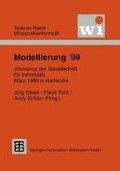Zusammenfassung
Die Modellierungsmethode SeeMe unterstützt die Darstellung sozio-technischer und semi-strukturierter Aspekte von Kommunikations- und Kooperationsprozessen. Aktuell besteht auf akademischem Gebiet und auch in der Softwarebranche ein großes Interesse an Modellierungsmethoden. Die Schwerpunkte liegen dabei u.a. in der Integration bekannter Modellierungsansätze [BoJR98] oder in der Bewertung der Qualität von Informationsmodellen (z. B. [Rose96], [Schü98]).
Access this chapter
Tax calculation will be finalised at checkout
Purchases are for personal use only
Preview
Unable to display preview. Download preview PDF.
Literatur
Booch, G.; Jacobson, I.; Rumbaugh, J.: The Unified Modeling Language User Guide. Reading, Mass. et al.: Addison Wesley 1998.
Goguen, J. A.: Requirements Engineering as the Reconcilation of Technical and Social Issues. In: Jirotka, M.; Goguen, J. A. (eds.): Requirements Engineering: Social and Technical Issues. London et al.: Academic Press 1994. S. 165–200.
Gruhn, V.: Validation and Verification of Software Process Models. Forschungsbericht Nr. 394/1991. (Dissertation). Dortmund: Universität Dortmund 1991.
Green, T.R.G.; Benyon, D. R.: The skull beneath the skin: entity-relationship models of information artifacts. Int. J. Human-Computer Studies 44 (1996) 801–829.
Harel, D.: Statecharts: A Visual Formalism for Complex Systems. Science of Computer Programming 8 (1987) 231–274.
Herrmann, Th.: Zur Gestaltung der Mensch-Computer-Interaktion: Systemerklärung als kommunikatives Problem. Tübingen: Niemeyer. 1986.
Herrmann, Th.: Communicable Models for Cooperative Processes. In: Slavendy, G. (ed.): HCI International ‘87. Proceedings of the 7th International Conference on Human-Computer Interaction, San Francisco. Amsterdam: Elsevier 1997. S. 185–188.
Herr99] Herrmann, Th.: Flexible Präsentation von Prozeßmodellen. In Proceedings der 9. Fachtagung Software-Ergonomie ‘89. Design von Informationswelten. (Im Erscheinen)
Kraut, R. E.; Fish, R. S.; Root, R. W.; Chalfonte, B. L.: Informal Communication in Organizations: Form, Function, and Technology. In: Baecker: Readings in Groupware and Computer-Supported Cooperative Work. Morgan Kaufman 1993. S. 145–199.
Kuutti, K.: Identifying Potential CSCW Applications by Means of Activity Theory Concepts: A Case Example. In: Turner, J.; Kraut, R. (eds.): CSCW ‘82. Sharing Perspectives. Proceedings of the Conference on Computer-Supported Cooperative Work. ACM 1992. S. 233240.
Nygaard, K.: Program Development as a Social Activity. In: Kugler, H.-J (ed.) Information Processing 86. Elsevier Science Publisher B.V. 1986. S. 189–198.
Oberquelle, H. (1987): Sprachkonzepte für benutzergerechte Systeme. Berlin: Springer 1987.
Rosemann, M.: Komplexitätsmangement in Prozeßmodellen. Methodenspezifische Gestaltungsempfehlungen für die Informationsmodellierung. Wiesbaden: Gabler 1996.
Scheer, August-Wilhelm: ARIS-Modellierungsmethoden, Metamodelle, Anwendungen. 3. Aufl. Berlin et al.: Springer 1998.
Schütte, R.: Vergleich alternativer Ansätze zur Bewertung der Informationsqualität. In: Proceedings der Fachtagung MobIS’98. Informationssystem Architekturen. Rundbrief des GI Fachausschusses 5.2. 5. Jg., 2 (1998) 49–55.
Sillince, J. A. A.: A Model of Social, Emotional and Symbolic Aspects of Computer-Mediated Communication within Organizations. In: CSCW Vol. 4 ( 1995 ). Kluwer Academic Pub. 1996. S. 1–32.
Author information
Authors and Affiliations
Editor information
Editors and Affiliations
Rights and permissions
Copyright information
© 1999 Springer Fachmedien Wiesbaden
About this chapter
Cite this chapter
Herrmann, T., Hoffmann, M., Loser, KU. (1999). Modellieren mit SeeMe — Alternativen wider die Trockenlegung feuchter Informationslandschaften. In: Desel, J., Pohl, K., Schürr, A. (eds) Modellierung ’99. Teubner Reihe Wirtschaftsinformatik. Vieweg+Teubner Verlag, Wiesbaden. https://doi.org/10.1007/978-3-322-93104-7_4
Download citation
DOI: https://doi.org/10.1007/978-3-322-93104-7_4
Publisher Name: Vieweg+Teubner Verlag, Wiesbaden
Print ISBN: 978-3-519-00274-1
Online ISBN: 978-3-322-93104-7
eBook Packages: Springer Book Archive

